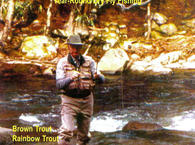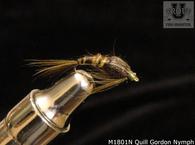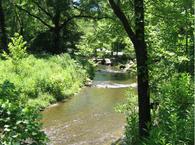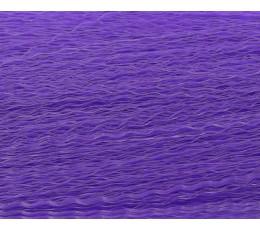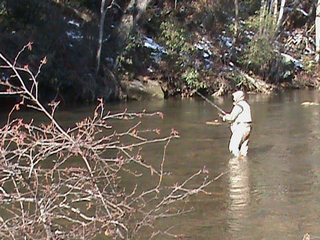
In this class, the student will learn about the effects of springs that are submerged as well as those flowing into the stream. The student will learn how to take advantage of the changes in temperature brought about by the springs as well. The student will also learn how to fish the banks, with consideration given to the shrubs, and sunken logs. No study of banks is complete without understanding the important use of terrestrials.
Don't Ignore Springs . . .
In the early and late season a spring or small tributary entering a pool will concentrate the fish. Springs reflect the average mean temperature of a given latitude, and because of the insulating effect of the ground they hold a constant temperature year-round, just as your basement does. So in early spring, when the river water is 45 degrees, the temperature of an entering spring could be closer to 50, a more comfortable temperature that will encourage more feeding. In August, when the temperature of the river is 72 degrees with a corresponding decrease of oxygen, the spring will be around 55 degrees, and it may often be a question of survival rather than mere comfort that keeps trout with their noses stuck into the cold water. The Firehole in Yellowstone Park is a river that suffers from high summer water temperatures because of the hundreds of geysers, mud pots, and boiling water pools that flow into it. One August day I found a cold spring flowing into the Firehole opposite the famous Ojo Caliente hot spring. There were more than twenty trout packed into a shallow, barren flat below the spring, and they were unusually spooky, but I found that a tiny Pheasant Tail nymph dropped into the crowd would get a nod if I rested the pool after the previous fish I'd taken. It was the first time I had fished the Firehole, and had I not wanted desperately to catch a trout there, I would have left them alone, as they were vulnerable and stressed by living in this crowded, exposed environment. Since that day I have avoided cool springs in extremely hot weather, preferring to fish near them only when a couple of trout have moved in for comfort, not when an entire pool has migrated there out of desperation. You're the predator, though, and you can make that decision on your own.
. . . or the Banks

Reading the water by looking at the banks is often ignored, but the banks in many streams (not just meadow streams with undercuts) are the most important fish-holding features. Unless a bank has a shallow slope without cover and is made from fine gravel or the water along it is so shallow that a trout's back would poke out, you'll find trout somewhere along this edge. Generally one bank is better than the other. When you're fishing blind, fish are spookier than if they're preoccupied with a hatch, and because you'll have to favor one of the banks when wading up or down (unless the river is so big you have to fish the same bank you're wading), it's important to look over both banks before you enter the water.

If the river is so fast in the middle that it is difficult for you to wade, there is nothing to break the current, and there are no twists to make current seams, you can be certain that any decent trout around will be near one or both banks. Which one should you choose? Just as you evaluated the middle of the pool, look at the head of the pool or riffle to see where the current is directing most of the food. Usually the current will bounce the main volume of water toward one bank or the other. But wait, you say; trout don't need to worry about aquatic insects when they live near the banks because they have plenty of terrestrial insects falling right on top of their heads. It's true that in some rivers terrestrial insects make up the bulk of a trout's diet, but contrary to what most fishermen say and believe terrestrial insects are no more important to trout near the banks than to trout in the middle of the river. I remember casting to a large brown trout rising to leafhoppers and beetles in an upstate New York river one windy day, and I counted thirteen fly changes until I got him to take. He was in the middle of the river, fifty feet from either bank. One early morning on the Madison I walked the bank upstream from the Raynolds Pass Bridge. I rose dozens of bigspotted browns on a hopper right next to the bank, but when I turned my attention to the middle, the rainbows on the seams of the fast water ate the hopper just as eagerly.
There is a simple reason for my not thinking terrestrials are more important to fish living near the banks: An object falling into a river is quickly drawn into the center. If a grasshopper or cricket or beetle or ant falls into the water and isn't eaten right away by a trout living next to the bank, it will soon be available to those guys out in the center. In tiny brooks or shallow streams the deeper bank is usually better. You should make sure, however, that some current is getting to the deeper bank, because sometimes the deep bank is an almost stagnant backwater. Huge trout can use these deep places for refuge, but they don't eat there, so trying to get one to take is like pitching to a batter while he's sleeping. If one bank slopes gently up from the river and the other is made from ledge rock or is otherwise steeper, the steep bank is likely to be better. In huge, fast rivers where the current along the deeper bank might be moving at ten feet per second and the water might be twenty feet deep, I'd take a look at the shallower bank first. There might be a trout underneath that twenty feet of fast water, but you're not going to have much luck getting a fly to where he'll see it and feel inclined to move for it.
Once you've identified the better bank, make sure as you fish that you keep your eye on where the good water peters out, as often the good water switches from one bank to another. Because you're not looking for rising fish but casting to likely stream features, you can sometimes tighten the blinders too much and wade right through some water you should be fishing rather than blundering through.

Any object that breaks up the outline of the bank will increase its attractiveness to trout. Where a deep riffle runs along a bank, look for a point of land that sticks out. Just like a rock in the middle of a river, the point will form two choice places for trout to lie — one just upstream of the point where the water is backed up to form a dead spot, and another area just downstream. If the point sticks out more than a foot from the bank, you might think that the most or best fish will be found close to the bank in the backwater right behind the point. My experience has shown that most trout, and certainly the bigger ones, prefer to lie just inside the seam behind the point. This place makes sense for trout because it offers protection from the full brunt of the current and easy access to food being carried by the current. If you toss a twig into the backwater behind an object, it will whirl around for many revolutions before it rejoins the current, and some fishermen argue that trout like to be in backwaters because they get multiple looks at pieces of food. I think they are more concerned with getting enough to eat than with admiring their next meal.
I also like to think this is true because getting a fly behind a point of land just inside a fast current and maintaining a natural drift is difficult without throwing piles of slack or adding a six-foot tippet. I'd rather throw my fly into the easier current just outside the point for a longer natural drift and hope the trout just inside can easily slide over and inhale my fly. If he is tucked way back, he may still see my fly and rush over for it. Only after I've attempted every permutation of drifts on the outside will I try the nasty water in the backwater.
A tree that has fallen into the water at a right angle to the current, usually with the trunk still attached to the bank, is called a 'sweeper.' The best places near a sweeper are at the outside tip of the branches extending downstream along the seam, and in front of the crotch where the sweeper meets the bank. Both places offer breaks from the current and a steady food supply. Often a line of trout extends below the tips of the branches, with the biggest fish upstream and the size decreasing as you go downstream, because a trout will not tolerate a smaller or less aggressive fish in front of it. Downstream of the sweeper is often barren water. If it contains trout, they'll be much smaller than you'd think, because the sweeper strains food from the current and pushes it to the outside leaving slim pickings to the trout behind.
A log lying parallel to the current will probably hold more trout than a sweeper of the same size, because the entire length of the log offers attractive feeding grounds. When I was a teenager, I fished a productive stream that runs through the limestone bedrock of upstate New York. This river had all the attractive haunts a trout stream could possibly offer, but as far as my sampling could determine, one log in particular held the biggest fish. About fifteen feet long and five feet from the bank, the log always held several small trout; two six-inch nubs were left from branches that had been broken off over the years. And anchored at these nubs were the two best trout in the pool, one twenty inches long and the other nineteen. All these trout fed on the outside edge of the log, and even though there was a good five feet of dark, deep, protected water between the log and the bank, I never saw a trout rise and never caught one there.

How the Setting Can Change
Four minutes from where I sit in an office eight hours a day is a tiny stream that is my laboratory, escape valve, and forty-five-minute retreat. I can fish three or four pools on my lunch hour. In one favorite half-mile stretch I know virtually every fish except the unseen brown trout that I suspect inhabit a couple of deep undercut banks at the base of streamside maples. I have never caught one of these elusive browns, but I imagine them sulking in a tangle of drowned roots, oblivious to my flies but capable of eating a six-inch brook trout followed by a three-day fast. At the beginning of each season I mark a couple of gullible brook trout by clipping their adipose fins so I can follow their progress through the season. If I can figure out where they are living, I can almost always catch them. In early spring they are in the deeper, slower pools, and to catch them you need a large nymph fished close to the bottom, with no drag at all. As water temperatures rise above 55 degrees and flies start to hatch, they will be pulled from the pools into shallow riffles. Now a dry fly will work, as will a wet fly or nymph that swings across the current. As water levels fall during the summer, they can be hard to find, and whenever I fail to catch one that has been in the same spot for a couple of months, I start to imagine my brookie in an aluminumfoil coffin in somebody's freezer, or in the belly of a heron or otter. With the lower water levels it's also likely that there are fewer places in this little stream that can hold trout, and my friends were pushed downstream by more aggressive trout. In summer most of the trout are concentrated in only the deepest holes and in the heads of pools — it may be a hundred feet between places that hold trout.
During the winter and early in the season trout are more concerned with avoiding anchor ice and floods than they are with eating. There are few insects in the drift for them to capture, and their metabolisms are slowed to the point where they take little advantage of the food that might be available. Shallow water can be scoured by floating ice and anchor ice, which grows from the bottom of the river, so look for trout in deep-water refuges, out of the main current. When there is no ice, though, I have caught them on sunny days in shallow riffles, and because I doubt trout spend the winter in water like this, I suspect they move into places that are warmed by the sun as spring starts to wake up the river. As the water temperature approaches 50 degrees, and insects begin to drift and hatch, the fish migrate to shallow riffles and the heads of pools to take advantage of insect life at its source. You can gauge the migration time by the first major hatch of the season. In the East, if you blind-fish before the Hendrickson hatch, you'll find most trout in the side eddies and backwaters, but as soon as this first big hatch begins, the trout appear in riffles, in tails of pools, and out in the main current. They're still there on days when the flies don't hatch, and early in the morning on days when flies don't hatch until midafternoon.
There they will stay until low water and high temperatures shrink the comfortable places in a stream and concentrate the trout. As habitats contract, trout don't move far, sometimes just from one side of the pool to another, or from the middle to the head. In the tail of a big pool on the lower Battenkill, I found a pod of a half-dozen large brown trout one late spring evening, and I returned a couple of evenings a week to work them over. By the middle of the summer I had caught and released most of them, including a couple that I fin-clipped. A vacation kept me away from them for ten days, and when I returned the places where they had been feeding were almost dry. I couldn't find a single one. One night I happened to look at the other side of the river, which was deeper but had never produced a fish, I guess because this deeper pocket was out of the main current and did not supply enough food. There were several good fish rising there, and sure enough, over the next several weeks I caught some that I had clipped. As I looked carefully at the water, I saw that their new home was deep enough to keep them secure. The current had shifted because of a newly exposed gravel bar, and by the looks of the bubble line coming down through the pool, most of the food was now funneled to the opposite side of the river.

In the tough late season there are three keys to finding trout: temperature, oxygen, and flow. If you remember them, you will catch trout all day long, even in the noonday heat of August when there is slim chance of any kind of hatch.
Temperature: Look for springs entering the river. Even springs whose surface flow runs dry during the summer usually offer some flow below the dry channel, so a scar of clean rocks along the bank that looks as though it might have been a tributary in early spring may tip you off to some cooler water. In general any entering tributary will be cooler than the main river, so look for trout below the confluence of a smaller and a larger stream. Wade wet to find springs entering the river beneath the streambed.
Oxygen: Water's oxygen content is inversely related to its temperature, so if you can't find the cooler water, which holds more oxygen, look for places where oxygen is forced into the water by physical means. Riffles, runs, pocket water, the bases of dams — trout will move to these places in midsummer, often leaving the rest of a pool barren.
Flow: This important factor of midsummer trout fishing is often overlooked. Trout won't live where they can't eat, and during low water their options are limited, making stream reading easier. Especially in slower pools, don't look for trout anywhere but right under the bubble line, because flow is reduced to a point where only the main current offers enough food. If you can't locate the bubble line or it doesn't seem to help, another way of finding trout is to look at the stones on the bottom. Once when I was fishing a stream known for its wild rainbows, I was in a wide riffle that holds scores of trout during the spring, and I knew some of them had to be around, even though the water looked too shallow. At first the entire riffle looked daunting and I couldn't decide where to start. Then as I stared at the water, I noticed something. Most of the rocks on the bottom were covered with a thin film of dusty-looking silt, but in places that were slightly deeper and had a stronger current, the rocks had been wiped clean. That gave me some targets, and by pitching a Flashabou Caddis Larva into the narrow lanes of clean stones, I picked up a half-dozen ten-inch fish, more than I would have expected in such a flat, shallow riffle. Exerpts from The Orvis Guide to Prospecting for Trout. by Tom Rosenbauer
Put on some polarized sun glasses and explore some of your favorite streams, concentrating on the springs and the banks. Become aware of the changing settings and how to fish them. Continue on to Class 3677 Prospecting For Trout II.
Recommended DVDs:
Fly Fishing for Trout in Tailwaters
Fly Fishing Strategies That Catch Trout
Read the The Orvis Guide to Prospecting for Trout.
Class material has appeared in MidCurrents.


